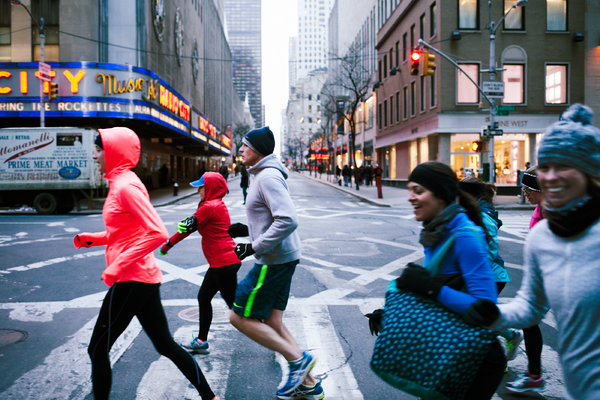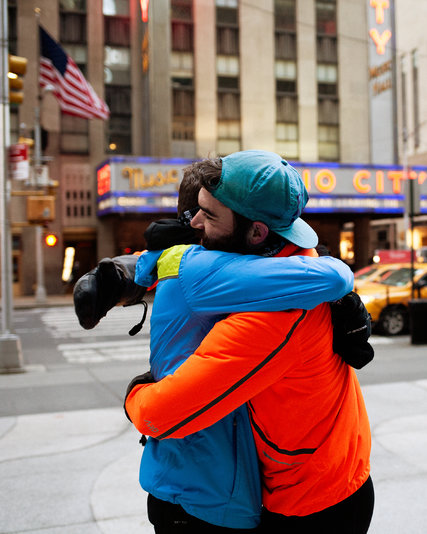Where most people see beloved New York locales, John Honerkamp, Paul Leak and their merry band of some 100 followers see prime exercise sites.
One morning last year at precisely 6:28, the group descended on the steps of the Metropolitan Museum of Art for perhaps the most physical game of Pictionary ever played: Athletes sprinted to pick up clues, held plank poses while team members sketched and performed penalty burpees (an explosive squat/push-up combination) for failing to guess correctly.
They have done wall sits and stair runs at Borough Hall, “mountain climbers” outside Gracie Mansion (where security guards cheered them on) and relays around the Lincoln Center fountain (though they were soon asked to leave).
And on a recent 19-degree Friday morning, they used another Midtown fountain for jumps on and off its two-foot-high ledge, although Mr. Leak was already making more ambitious plans for the water.
“This would be perfect for an urban triathlon, but there’s not a Citi Bike station nearby,” mused Mr. Leak, 27, whose later-in-the-day job is event management. “We would entirely get in trouble, but we love that.” (Mr. Leak also has designs on the Staten Island Ferry.)

Members of the New York Tribe running along the Avenue of the Americas. Workouts utilize public spaces and are never canceled.
Mr. Leak and Mr. Honerkamp, 39, are the New York leaders of an early-morning workout flash mob known as the November Project, which began in Boston in 2011 and has since spread to 19 cities in the United States and Canada. It’s a point of pride that the group — not quite running club, not quite boot camp — defies categorization. It blends the intensity of CrossFit, the cultishness of SoulCycle and the weather agnosticism of a Polar Bear swim with the high jinks of an obstacle course and the camaraderie and accountability of a sports team.
Workouts in Boston have drawn more than 1,400 people, among them Olympic and professional athletes. Rodale plans to publish a book about the November Project in 2016.
Sessions open with members — new exercisers and marathoners alike — being instructed to touch the nose of someone they don’t know and tell the person, “I’m happy you’re here.” Handshakes upon meeting are forbidden; this is a hugs-only zone. And because workouts are free and outdoors, there’s no booking hassle, unforgiving cancellation policy or scramble for a spot. Take that, $35 boutique fitness class. (November Project has recently begun working with sponsors: Last year, North Face was among the companies supporting the group’s annual summit, and beginning next week will team up with it on another project.)
Brogan Graham, 32, a former college rowing coach who is one of the group’s founders, said: “Some people need their exercise to be certified and sanctioned and expensive. We just want to have more fun.”
He added, “We’re making people be people and put their” — expletive — “phones down.” (Said phones do reappear at the end for the obligatory postworkout group photo, promptly posted to social media.)
Kaitlin Fuelling, 23, who moved to the Lower East Side from Pasadena, Calif., in 2013, said November Project friendships account for the majority of her social life.
“I did the stint with a gym, but I was looking for people I could kind of relate to,” Ms. Fuelling said breathlessly between “hoisties” — November Project lingo for squat jumps done while pressing one’s palms against a partner’s. “Everybody thinks it’s a little crazy, but once you go you can’t even explain how much fun you have.” She has kept her membership at 24 Hour Fitness, but “just for the shower.”
Leaders of each city’s tribe, as the November Project calls its affiliates, are volunteers with athletic backgrounds whose only instructions are that locations must be epic and that workouts must start at 6:30 a.m. (or before), be scalable for all levels of fitness — and unpredictable.
In San Francisco, organizers drew a version of the board game Chutes and Ladders on the cement of Alamo Square, requiring different exercises to traverse the board.
A San Diego session in January involved teams of four pushing Toyota Priuses, with participants instructed to stand between the cars’ rear taillights so feet couldn’t be run over, recalled Mr. Graham, who was visiting at the time. (No one factored in a slight downhill to the course, so the workout involved an extra cardio challenge: chasing runaway cars.)
Like many crazy ideas, the movement grew out of a late-night bar chat, this one in October 2011, when Mr. Graham and his former Northeastern University rowing teammate Bojan Mandaric, 33, decided to head off the winter tendency to slack on exercise by making a pact to train every day before work the next month. They tracked their workouts on a Google document named the November Project.
“We thought if we did it, we’d become morning people and also more connected,” Mr. Mandaric said. “Even if it’s your best friend, people get busy. But nobody is busy at 6:30 in the morning.”
As they kept the project running past its intended expiration date, they created a blog and Twitter account, and people they didn’t know began showing up for what became their signature Wednesday morning session: running the stairs of all 37 sections of Harvard Stadium, a workout known as the “full tour.”
One early convert — whose huge Twitter following helped spread the November Project gospel — was Andrew Ference, then a defenseman for the Stanley Cup-winning Boston Bruins just trying to stay in shape during the 2012-13 National Hockey League lockout.
“I didn’t know what was going on with the hugging and hooting and hollering, but everyone was really cool,” said Mr. Ference, who learned of the group from a bicycle shop. “I went and chased these fast dudes around the stadium, and I just kept going back.”
He has since moved to Edmonton, Alberta, where he is the captain of the Edmonton Oilers and a November Project leader. He is also the creator of November Project’s most coveted badge of honor: a Boy-Scout-like circle patch with “-30” written in blue. It is given to anyone who shows up to a workout when the thermometer reads that number or below. So far, no November Project workout has ever been canceled because of weather.
Anyone who has promised to come (“dropped a verbal,” in November Project parlance), and then doesn’t, appears on the “We Missed You” page of the blog. No matter what the excuse, the November Project makes it look as if the absentee was out partying by pulling old photos from a Facebook page that show him or her drinking or eating nachos. It is a shame theory of accountability that featured in a TEDx talk Mr. Graham and Mr. Mandaric gave recently.
“It’s in jest but it works,” said Peter Kruse, 27, who lives in Midtown. This winter, he arrived three minutes late to a workout when the wind chill was minus 10 because the ski goggles he wore had fogged up and he missed a turn. The group had left, but Mr. Kruse raced to catch up.
“That was a real low point,” Mr. Kruse said.
To start a chapter in a new city, there is a strict pledge process. (At least it’s strict by November Project’s freewheeling standards.) Aspiring leaders spend a year proving they can attract a following before they are allowed to use the November Project name. They start with a Wednesday morning workout — Wednesday because no one is recovering from the weekend or getting on a plane for a coming weekend — and eventually add Fridays, then Mondays. They are encouraged to start in the dead of winter, to attract a core group of die-hards, because summer members can be fair-weather participants.
On a recent Friday, about 30 members of the New York group, most of them in gear spray-painted with the graffiti-like November Project logo, huddled in a passageway in Midtown near the Fox News studio.
They warmed up by jumping up and down, turning in midair and yelling “Fox” on the ascent and “Friends” when they landed. They ran past Radio City Music Hall calling to people they passed to “have a spectacular day,” and they face-planted on the concrete after their arm muscles failed from seven minutes of push-ups and triceps dips before 7 a.m.
Mr. Honerkamp urged them closer. “We need subway close; we need the 6 train close,” he yelled. “If anyone’s new, it might be a little awkward, but that’s the point.”
Source: The New York Times
March 25. 2015
By Courtney Rubin, photos by An Rong Xu
http://www.nytimes.com/2015/03/26/style/the-early-morning-workout-flash-mob.html?emc=edit_tnt_20150326&nlid=27719423&tntemail0=y&_r=1












